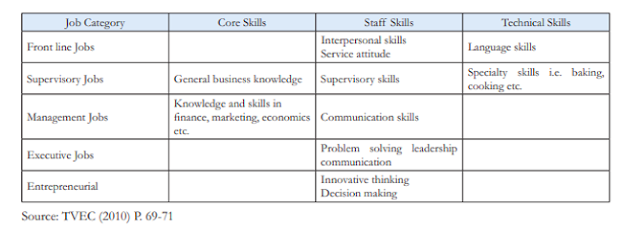Tourism is one of the fastest growing industries in the world that is also one of the drivers of economy in many nations. This industry creates a repulse across the country by its affect to other industries. If we look at the past 10 years, we notice that it has created many opportunities in Sri Lanka as well as in other developing countries. As same as the tourism industry has created more job opportunities, simultaneously it contributes to the economy of the country. Number of opportunities that this industry creates are unquestionable however, the quality of the opportunities that are being emerged in the travel and tourism sector has been quite questionable.
There are 2main definitive categories of job opportunities in the travel and tourism industry (Deb.R.,2020).
- High built Jobs – Highly Attractive, has high working status environment, competitive pay, full of professionalism, has low staff turnover, more importantly the jobs that require more skills.
- Low Built Jobs – Less Attractive, High staff turnover, with low working status environment, Less Pay, No or low sense of professionalism, low skilled jobs
Organisations and managers in travel and hospitality industry, faces real challenges in recruiting, developing, mentoring a competent, a committed, a well-managed and a well-motivated workforce whose focus is on delivering a quality service to their customers and there by generating a quality travel experience to customers (Čerović, S., 2020).These facts are significant in creating a tourism and hospitality organizational success, effectiveness, competitiveness, productivity and more importantly this adds up to the organizational profitability. What we have tried to emphasise above is that the industry needs for quality workforce, moreover we could make a remark as that the Human element plays a huge role in growth and development of Tourism and Hospitality trade (Dwyer, L. and Kim, C., 2003) Also, when we closely evaluate, we notice that the industry is undergoing through a paradigm shift.
Before concentrating on hospitality industry, we find this in the case of hospitality sector the quality of customer service and staff responsibility has got a direct impact on the image and reputation of organization. And this creates the bottom line of the organization.
HR practices outlined by Redman and Mathews (1998) to achieve high quality service are,
- Recruitment and selection,
- Retention,
- Teamwork,
- Training and development,
- Appraisal,
- Rewarding quality,
- Job security,
- Employee involvement and employee relations
“The most widely used definition of human resource management is the one defined by Snell and Bohlander (2010) which describes it as a process for managing human capital to achieve the organization’s goals. “The hospitality industry is a labour-intensive industry, and this feature provides an excellent research environment for exploring HRM issues. In addition to having essential and practical HR functions, such as integrating resources, managing employees, cultivating capabilities, formulating strategies, improving performance, and achieving organizational goals, hospitality HRM also needs to assist the hotel industry in providing high-quality services to customers and maintaining customer relationships, moreover, promoting core competencies while the pursuit of organizational success. In addition to this, the people in the hospitality sector include both employees and customers. Therefore, HRM for hospitality is recognized as a critical element for connecting customers and transforming services, building core competencies, and improving internal and external performance” (Guerrier, Y. and Deery, M., 1998.) When we try to get the best people in the market, some of the issues which we basically face, first the pay structure and working culture of the organization. These are the issues as a manager which one must deal with.
According to Sri Lanka Tourism Development Authority (2018), there are more than 400,000 direct and indirect tourism and hospitality employees in the industry. In terms of its contribution to GDP, the sector accounted for 12.6 percent of total GDP in 2019. Since the hotel and tourism sector like most service sub-sector engages in labour-intensive activities, a doubling or tripling of tourist numbers will generate commensurate growth in employment. The resulting employment growth can be expected to take place both directly in the hotel sector, as well as in sectors such as tours and travels, hospitality, food and beverages and entertainment. Sri Lanka needs skilled labour and in need of retaining skilled labour in the country. The industry is now looking at robust talent management strategies to fill in the two categories of jobs. Table 1.0 highlights the direct workforce in the tourism service sector and the Table 2.0 highlights the structure of industry employments in Sri Lanka.
Source: Sri Lanka Labour Force Survey, Annual Report (2019)
Table 3.0: Skill requirements of the tourism sector,2013-2017
Deb (2020) Outlines key Best Practices for talent management and high levels of customer centricity.
- Creating internal talent pools,
- Developing collaboration by eliminating information silos,
- Meaningful customer service values,
- Aligning corporate strategy with individual roles,
- Employee empowerment,
- Executing enterprise-wide transformation,
- Change should start at the top,
- Clearly communicating the message,
- Explaining how change affects employees individually,
- Involve every layer
Conclusion: It is now determined that majority of the above mentioned key best practices can only be done in a service organization/ Tourism and hospitality organization only if they retained employees with the best training methods. In simple, one cannot create an internal talent pool, develop a collaboration by eliminating information silos, provide a Meaningful customer service value, align corporate strategy with individual roles, empower employees, Execute enterprise-wide transformation, communicate Clearly, provide awareness on how changes affects employees individually, make employees aware the interrelation of them and the organization or Involve every layer of an organization, without a better training and development environment.
Training is the tool that improves skills of the organization (Olaniyan, D.A. and Ojo, L.B., 2008). That's why in most organizations, just after selecting their employees in part them in quality trainings. With the training employees can develop themselves as skilled employees of the organization. Different companies and different industries have different ways of training their employees. But more important in the service sector. This is an industry which needs more human efforts, more human contribution. This is an industry where people/customers will directly be communicating with employees of the organization. so, they should have all the skills equipped with so that they can contribute with immensely to the organization (Dimitrov, D., 2012).
Reference
Čerović, S., (2020). IN HOSPITALITY INDUSTRY.
Deb, R. (2020) Human Resource Management in Tourism & Hospitality Industry (2nd Sem, MBATH) [Presentation]. Available at: https://youtu.be/iDWeId4v4tE (Accessed: 23 April 2022).
Dimitrov, D., (2012). Sources of meaningfulness in the workplace: A study in the US hospitality sector. European Journal of Training and Development.
Dwyer, L. and Kim, C., (2003). Destination competitiveness: determinants and indicators. Current issues in tourism, 6(5), pp.369-414.
Guerrier, Y. and Deery, M., (1998). Research in hospitality human resource management and organizational behaviour. International Journal of Hospitality Management, 17(2), pp.145-160.
International Labour Organization (2015) The skills gap in Four Industrial Sectors in Sri Lanka. ILO Country office for Sri Lanka and Maldives
Olaniyan, D.A. and Ojo, L.B., (2008). Staff training and development: A vital tool for organizational effectiveness. European journal of scientific Research, 24(3), pp.326-331.
Redman, T. and Mathews, B.P., (1998). Service quality and human resource management: A review and research agenda. Personnel Review.
Sri Lanka Labour Force Survey, Annual Report (2019)
Snell, S. and Bohlander, G.W. (2010) Principles of Human Resource Management. Mason; South-Western Cengage Learning
TVEC, (2010), Vocational Education and Training Plan, Information and Communication Technology Sector




Well, Ruwini, you have successfully explained HR's role in the tourism and hospitality industry. Adding more HR takes a more subservient approach, aiming to keep everyone happy by constantly tweaking the system and process according to staff feedback and senior management direction (Armstrong and Ward, 2005).
ReplyDeleteI agree Krishan, that's the theoratical background to the role, however in most cases, employees are not happy in organizations, specially with the HR department. Jiang, Baker and Frazier (2009) states employee confessions which says that delays in conflict resolutions and poor employee relations as some of the main causes for their unhappiness within their organizations and with their HR departments.
DeleteJiang, B., Baker, R.C. and Frazier, G.V., 2009. An analysis of job dissatisfaction and turnover to reduce global supply chain risk: Evidence from China. Journal of operations management, 27(2), pp.169-184.
ReplyDeleteTourism & Hospitality was one of badly affected industry from the pandemic. Especially due to Travel restrictions/lock downs which occurred all over the world. In this post pandemic Era having a proper strategy for HRM is a very important factor for an organization . According to Ngoc Su, Luc Tra, Huynh, Nguyen & O’Mahony (2021) the new face of the organizations depends upon the modified framework of strategies and competencies developed for the manpower. This modification takes place concerning the challenges of the pandemic and the changes in the return of it in the organizational environment. The aftermath of the COVID-19 pandemic affects numerous resources associated with an organization which leads to different transformations in them. Human resources are the most dynamic and versatile resource of an organization. They serve as the motivational factor that keeps the organization’s progress wheels in rotation and acts as an engross asset. Adegbile (2020) mentioned that due to the strength of the workforce behind completion of a work they are known as the manpower of an organization. Hence, the effectual management of manpower in every organization is the key to accomplish success in terms of productivity and profitability.
I agree with the insights that you brought through your literature review Naomi. Thank you!
DeleteBhutia, S., (2014) defines that Human resource role is essentially an enabling role to provide the right context in which human performance occurs & the industry reaches its stated objectives.
ReplyDeleteYes, Rifky thank you for further facts in understanding why HRM is important in an industry.
DeleteAccording to (Tiago -2020) The results of unveil and reinforce the importance of HRM alignment.in order to achieved high-quality service. Hence the hospitality discipline and extends the current knowledge regarding HRM practices affecting tourists’ service quality perception.
ReplyDeleteReference : Tiago, F., Borges-Tiago, T. and Couto, J., 2020. Human resources role in hospitality service quality. In Strategic innovative marketing and tourism (pp. 81-89). Springer, Cham.
I agree with the insights that you brought through your literature review Piyumi. Thank you!
DeleteAccording to the U.S. Bureau of Labor Statistics, human resource managers oversee the recruiting, interviewing and hiring of staff and serve as the bridge between management and employees. In the hospitality industry, HR must not only cultivate a skilled and dedicated talent pool but also retain it in a demanding job field.
ReplyDeleteI agree with the insights that you brought through your literature review Usama. Thank you!
DeleteHowever retainment of employees in the tourism and hospitality industry have been a challenge (Bharwani and Butt, 2012).
Bharwani, S. and Butt, N., 2012. Challenges for the global hospitality industry: an HR perspective. Worldwide hospitality and tourism themes.
According to Suharta Dewantara et al., (2019) Human resource procedures in the hotel business to comprehend the principles that apply to managers and staff workers We discovered that certain practices are applied equally to managers and staff members, while others are applied differently - notably, the practice related to a manager's role to function as a decision maker.
ReplyDeleteReference
Suharta Dewantara, I.W.G., Troena, E.A., Haerani, S. and Hamid, N. (2019). HUMAN RESOURCE DEVELOPMENT PRACTICES FOR ORGANIZATIONAL PERFORMANCE. Scientific Research Journal.